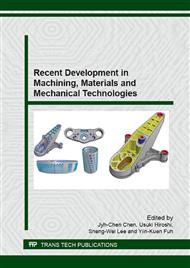p.314
p.320
p.328
p.335
p.341
p.347
p.353
p.357
p.363
Near-Dry Machining of Titanium Alloy with MQL and Hybrid Mist Supply
Abstract:
Near-dry machining attracts increasing attentions for environmental and economical benefits, and MQL machining has been recognized as the most representative near-dry method. It is highly successful in machining of most ordinary steels, and synthetic biodegradable polyol esters play a significant role as an effective cutting fluid with a very small amount. Recent concern for environmentally friendly manufacturing further encourages the attempts at applying near-dry operations to machining of difficult-to-cut materials. Since titanium alloys are typical difficult-to-cut materials, this paper investigates the cutting performance of various near-dry methods in turning of a titanium alloy from the view point of elongating the tool life. Those near-dry methods include regular MQL and hybrid mist supply operations, where the hybrid mist is a mixture of MQL mist and coolant mist which is atomized water-soluble cutting fluid. The regular MQL operation provided considerably long tool life compared with that of dry machining and the hybrid mist operation showed the possibility of making the tool life longer. The cutting performance was largely influenced by the type of MQL lubricants. In particular, a synthetic polyol ester lubricant having low viscosity indicated the successful cutting performance when it was combined with the coolant mist supply in the hybrid mist application.
Info:
Periodical:
Pages:
341-346
Citation:
Online since:
July 2015
Keywords:
Price:
Сopyright:
© 2015 Trans Tech Publications Ltd. All Rights Reserved
Share:
Citation:


